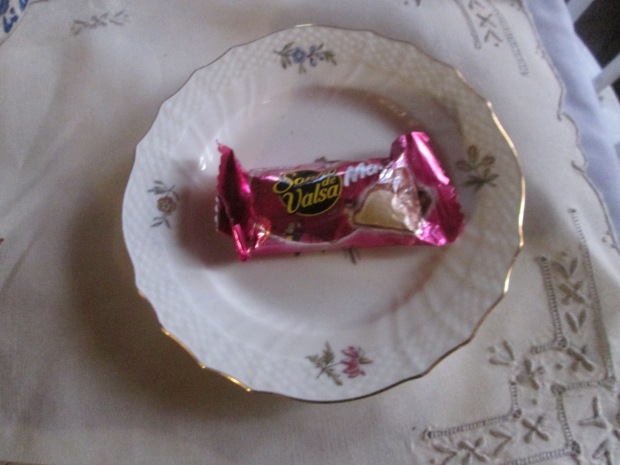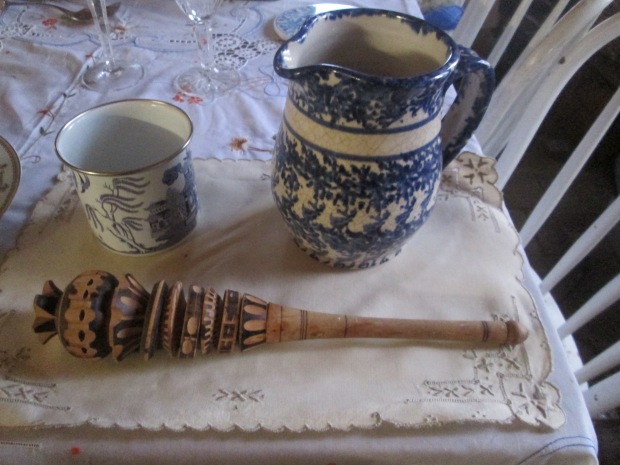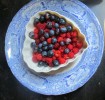

The name the Europeans gave to the cocoa bean, Theobroma cacao, food of the gods, is a splendid spin on the Nahuatl word used throughout the Aztec empire where Cortez found it, xocolatl. Imagine the frisson that went through the Spanish court when the Conquistadors talked about this seed that was so valuable it served as currency in New World. Imagine the PR person for Amalgamated Spanish Plunderers saying to Queen Isabella,
“It’s as precious as gold, Your Catholic Majesty. Why over there five beans will buy a rabbit, ten will buy a night with a prostitute–begging your pardon, Your Catholic Majesty, they are heathens, but a taste of the Inquisition’s strappado will fix that–and a hundred buys a slave.”
Imagine the queen’s reaction when she sipped the cold bitter drink made with ground up cocoa beans, cornmeal, chili, and cinnamon. I do not know the royal Spanish equivalent of “yuck, this is vile” but I suspect the queen uttered words to that effect. It took twenty years for the Spanish plunderers of Mexico to learn that the Aztecs fermented cocoa beans, to lessen their bitterness and that they often added honey and vanilla to their xocolatl to made it more palatable. This discovery coincided with the arrival in Spain of sugar from the Caribbean. The rest is history.
What intrigues me in the history of chocolate is the relative obscurity to which it relegated the Portuguese Jews who played an important role in bringing it to Europe. It is only recently that the chocolate manufacturers of Bayonne, France decided to highlight the contribution of these Sephardim. Now the Bayonnais talk openly about these Jews who, in flight from the Iberian Inquisition, turned Bayonne into France’s foremost center for chocolate manufacture. Sadly, a century the good Bayonnais had acquired the skills needed to take over the chocolate industry. Encouraged by the anti-Semitic propaganda of members of the chocolatiers guild, they threw out the Jews. For the latter, it was “deja vu all over again.” .
This historical footnote has a special meaning to me. Sephardim who fled to France early to avoid the Portuguese Inquisition, are among my maternal ancestors.They settled in northeast Brazil some five centuries ago. When the Dutch invaded that part of the world in 1630–a century after my Sephardic ancestors’ arrival in the New World–Jews were able to reestablish contact openly with branches of their European families.They were active participants in the sugar trade. Some of them traded in cocoa beans as well. It is possible that this imagined relative was among those to bring to France and Holland Maya and Aztec stories about the aphrodisiac qualities of the cocoa bean. But that is purely speculative. However, it is a matter of record the belief in chocolate as a sort of proto-Viagra took roots in the European imagination. Casanova is said to have fortified himself with it prior to amatory bouts. Louis XV, the well-loved, relied on a mixture of chocolate bars dissolved in boiling water and thickened with egg yolk to enhance his lovemaking with Mesdames Pompadour and du Barry. He was only one of many westerners to believe a legend that, so far, scientific research has failed to legitimize.
Though chocolate trading is not part of the documented history of my family, I cherish the thought that somewhere in the family tree there lurks a cocoa bean trader. Never mind that my childhood was devoid of chocolate treats. That strikes me as very peculiar. Brazil happens to be the sixth largest producer of cocoa beans in the world. Surely there was plenty to go around when I was little. Did its association with the bad habits of old roues keep it out of my menu? I doubt it. Maybe it was a simply a question of transportation. Roads linking my little town in Ceara to large urban centers were not the best. Consequently, most of the town residents led lives of utter self-sufficiency. Having no cocoa trees meant having no chocolate. Or did it? My parents happened to be economically comfortable. They traveled and shopped in larger places than my hometown. Why did they not bring home chocolate? I have no idea. All I know is that I only became a chocolate eater the year I turned thirteen. That year, I left home to go to school in the cool, verdant Cariri hills, miles away. That was my first solo voyage. At thirteen, I was thought to be capable of handling new privileges, new responsibilities.I took with me a secret Yom Kippur prayer my maternal ancestors had been passing on to their eldest child for five hundred years, school uniforms, and the burden of parental expectations. For the first time in my life, I had enough pocket to spend in candy shops. Was all this pure coincidence? Jewish girls that age become bat Mitzvah, but that is an innovation in terms of Jewish history. Besides, five centuries after Spain expelled its Jews, my family no longer connected with normative, Judaism. Ours is the memory of Jews in hiding. It records through a glass darkly.
Fact–at thirteen, I left home in the dubious company of my family’s driver, a murderer my father had sprung from jail–my father often hired clients from his law practice for jobs he alone thought they were qualified for. Presumably, he thought a murderer was a safe person to drive a sheltered teenager school. But my father and his endearing quirks are material for another post. Chocolate is the allegedly the topic du jour. Chocolate as in Sonho de Valsa, the cashew stuffed bonbons I savored along with Catholic novels of morals such as Henry Sienkiewicz’s QUO VADIS, Florence Barclay’s THE ROSARY, and appallingly sugary romances by M. Delly, such as MAGALI, Only Saint-Exupery and Jacques Prevert stood between me and complete idiocy
Besides halwa–especie, in northeast Brazilian Portuguese–made by maternal grandmother, I do not recall eating sweets other than chocolate while I was away from home. Delightful as my memories of weekends with the relatives who occasionally liberated me from conventual dreariness, I have no recollection of the food we shared. I only remember clearly the chocolate ice cream we would have at a little shop facing the cathedral where my teachers compelled me to attend mass every day. Chocolate then was the last sweet note of freedom from a regimented routine. Ever since no treat matches the nostalgic flavor of semi-sweet cocoa with a top note of vanilla. In my mind, it blends, exquisitely, with the sounds, scent, and sights of a Sunday kermess that brought the largest town square to life–the carousel that blared the Moulin Rouge song, the rustle of freshly starched clothes, the perfume of jasmine and red of tree blossoms, the glow of paper lanterns, the smell of buttered popcorn.
Years later, in the United States, I acquired a more sophisticated taste in chocolate. Thanks a friend whose relatives had a long lasting relationship with Viennese makers of bespoke chocolate, I graduated to artisanal treats. Later, in my food journalism days, I tasted Bolivian, Belgian, British, French, Italian Mexican, Swiss, and Venezuelan chocolate. I ate chocolate made in Vermont by a former White House chef, sampled handmade chocolate truffles in Italy, France, Spain, Switzerland, Hershey, Pennsylvania, and Martinsburg, West Virginia. Could I choose a particular brand over another? Yes. In the United States, I would choose Peter’s chocolate, occasionally available at King Arthur Flour, in Vermont. In Europe, I would choose the Austrian chocolate made for the Hungarian aristocracy, but the friend who used to share it died a few years ago. I never bothered to find out the name of her Austrian chocolate makers. All in all, I am not one of these folks who swear by Caillebaut, Cote d’Or, or Varlhona. I do not crave truffles made in the light of the new moon is some remote Oaxacan kitchen. Only rarely do I miss the hot chocolate I had in Spain, a concoction so thick one could stand a spoon in it–Spaniards thicken their drinking chocolate with cornstarch. I can live with American hot cocoa. I am OK with British and Swiss imports I can in most discount stores in the United States. As a rare treat, I indulge in Brazilian Sonho de Valsa bonbons. Thing is, to me, all chocolate is divine.I am grateful to the Sephardim for helping make it available to mere mortals.
Note: My immediate family has no ancestral recipes for chocolate. I hope someday to duplicate the chocolate halwa I had at the Rue des Rosiers, in Paris, years ago. It was a heavenly mix of Old and New World flavors.
